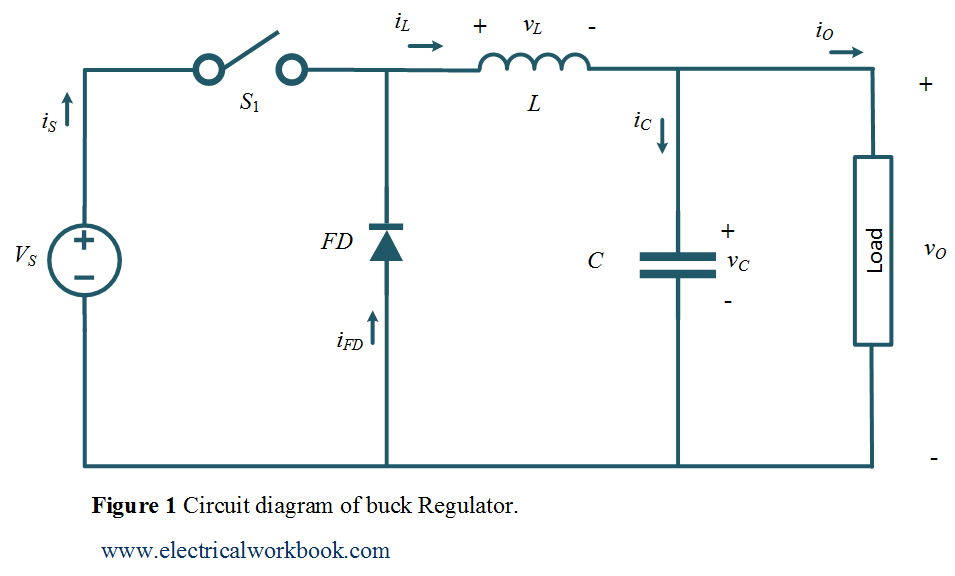In this topic, you study How to derive an expression for Peak to Peak ripple current and Condition of inductor maximum ripple current for Buck Regulator.
The buck regulator produces a lower average output voltage than the dc source input voltage. Let us assume large filter capacitance C connected across the load so that output voltage remains almost constant. The Resistive load is considered.
Circuit diagram
The working of a buck regulator is explained using the circuit diagram as shown in Figure 1. The switch ${S_1}$ shown in the circuit diagram can be a conventional thyristor i.e., SCR, a GTO thyristor, a power transistor, or a MOSFET.

Waveforms
The typical waveforms in the converter are shown in Figure 2.

Mode of Operation Interval 1: –
The time interval is 0 ≤ t ≤ ${T_{ON}}$. The switch ${S_1}$ is turned on. The circuit diagram for Mode of Operation Interval 1 is shown in Figure 3 and the corresponding waveforms are shown in Figure 2.

From the waveform of voltage across the inductor, as shown in Figure 2, the equation for the inductor voltage write as
\[{v_L}\hspace{0.1cm} =\hspace{0.1cm}{V_S}\hspace{0.1cm}-\hspace{0.1cm}{V_O}\hspace{1cm}….(1)\]
The general equation relates voltage across inductor and current passes through it as
\[{v_L} = L\frac{{d{i_L}}}{{dt}}\hspace{1cm}….(2)\]
Put Equation 2 in Equation 1 gives
\[L\frac{{d{i_L}}}{{dt}} = {V_S}\hspace{0.1cm} -\hspace{0.1cm} {V_O}\hspace{1cm}….(3)\]
The waveform for current passes through inductor L as shown in Figure 2, Integrate Equation 3 using maximum and minimum value of inductor current gives
\[\int\limits_{{I_{\min }}}^{{I_{\max }}} d {i_L} = \frac{{{V_S}\hspace{0.1cm} \hspace{0.1cm}- \hspace{0.1cm}{V_O}}}{L}\int\limits_0^{{T_{ON}}} d t\]
or
\[{I_{\max }}\hspace{0.1cm} -\hspace{0.1cm} {I_{\min }} = \frac{{{V_S}\hspace{0.1cm} – \hspace{0.1cm}{V_O}}}{L}.{T_{ON}}….(4)\]
Here $\Delta {I_L} = {\text{ }}{I_{\max }} – {I_{\min }}$ is the peak to peak ripple current of inductor L and hence Equation 4 can be write as
\[\Delta {I_L} = \frac{{{V_S}\hspace{0.1cm} – \hspace{0.1cm}{V_O}}}{L}.{T_{ON}}….(5)\]
The average output voltage for buck converter is given as
\[{V_O} = \alpha {V_S}….(6)\]
Also
\[{T_{ON}} = \alpha T = \frac{\alpha }{f}….(7)\]
Using Equation 5, Equation 6 and Equation 7 gives
\[\Delta {I_L} = \frac{{{V_S}\hspace{0.1cm}(1 – \alpha )}}{L}.\frac{\alpha }{f}….(8)\]
Equation 8 describes the peak to peak ripple current of inductor L in buck converter.
Condition for inductor maximum ripple current $\Delta {I_{L\max }}$
To get inductor maximum ripple current, differentiate Equation 8 with respect to duty cycle $\alpha$ and equate to zero,
\[\frac{{d\Delta {I_L}}}{{d\alpha }} = \frac{d}{{d\alpha }}\left[ {\frac{{{V_S}\hspace{0.1cm}(1 – \alpha )}}{L}.\frac{\alpha }{f}} \right] = 0…(9)\]
After solving Equation 9 gives $\alpha$ = 0.5 and put in Equation 8, so the inductor maximum ripple current is
\[\Delta {I_{L\max }} = \frac{{{V_S}\hspace{0.1cm}(1 – 0.5)}}{L}.\frac{{0.5}}{f}\]
or
\[\Delta {I_{L\max }} = \frac{{{V_S}}}{{4fL}}….(10)\]
Equation 10 describes the maximum ripple current of inductor L in buck converter.